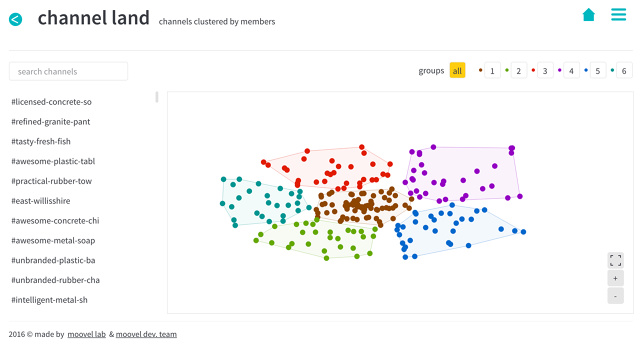Depending on whom you ask, Slack has either revolutionized the way workers communicate or created just another distraction in today's always-on lifestyle. How do you make sure your team is using Slack efficiently, and in a way that helps your company reach its goals—not just siloed in private chat channels all day, sharing cat GIFs?
Moovel, the urban mobility startup, struggled with this same question, so it teamed up with Benedikt Groß—creator of the accidental Google Earth typeface, Aerial Bold, and this alt-universe Tube map—to create #teamchatviz, a Slack app that visualizes your team's Slack data in real time.

Moovel has about 110 employees in Germany, and 110 employees in the U.S., all of whom have been using Slack for over a year to communicate on a daily basis. Although it's is now owned by Daimler AG, the German megacorp, Moovel is still run like a startup at heart, says Eileen Mandir, head of product and the Moovel lab. "It's a typical problem a lot of startups face as they get bigger: how do you stay agile at scale?" she says. To Moovel, staying agile means getting its teams to constantly cross-pollinate, which is why all of its Slack channels are public. The thinking is that individuals should be communicating with people besides their own teams, so that good ideas can become great ideas.
That's nice in theory, but was that actually happening? Moovel rejected just looking at spreadsheets of data, deeming them unsuitable for representing the complex way people interact across teams and hierarchy levels. "It would be like using Excel to visualize a swarm," says Mandir. They created #teamchatviz as a way of visualizing that swarm.
"The data ended up showing which channels and topics delivered on our goal for interdisciplinary, company-wide collaboration, and which teams in the company we needed to make a better effort connecting to the whole," says Mandir. In particular, Mandir says that while their product, development, and design teams were really good at collaborating, Moovel's marketing, sales, and business development teams tended to be more siloed. Moovel is now working to improve this by making sure there are designated representatives from each team involved in every new project from the outset.

While #teamchatviz can't give any insight into the performance of a team, or private messages, it can give helpful overviews of how people are communicating, both among themselves and within the company at large. The Channel Heartbeat tab of #teamchatviz lets you see what the most active teams in your Slack are, while People Land visualizes employees in arbitrary groups based upon the people they communicate with most on Slack, regardless of team.
Similarly, Channel Land groups Slack channels according to how many members they share; Messages and Reactions calls out the most influential messages on any given date, arranged by comments and reactions. Frequent Speakers is a sort of leaderboard, showing who the most influential (and just plain noisiest) Slack team members are. Finally, the Emoji timeline can be used to identify the most popular emoji both channel- and company-wide, and can even be used as a sort of high-level tool to see how teams are doing: for example, a team that uses a lot of angry face emoji might be overworked.
The interface feels like an extension of Slack's web-based UI, even adopting much of its typography and color choices. Likewise, the different visualizations are almost broken out like Slack channels, so if you've ever used Slack, you'll be right at home. And while there's an argument to be made that #teamchatviz could be just another distraction—well, that's in-keeping with the spirit of Slack itself, which doesn't shirk from fun and frivolous features like emoji and built-in Giphy support.
An open-source project, #teamchatviz is freely available for any Slack team to integrate. According to Mandir, she hopes that other companies will not only add new functionality to the app, but will be able to use #teamchatviz to gain better insight into how Slack is actually working within their organization. If you're interested in trying it out, you can explore an interactive demo of #teamchatviz here.
[All Images: via Slack]